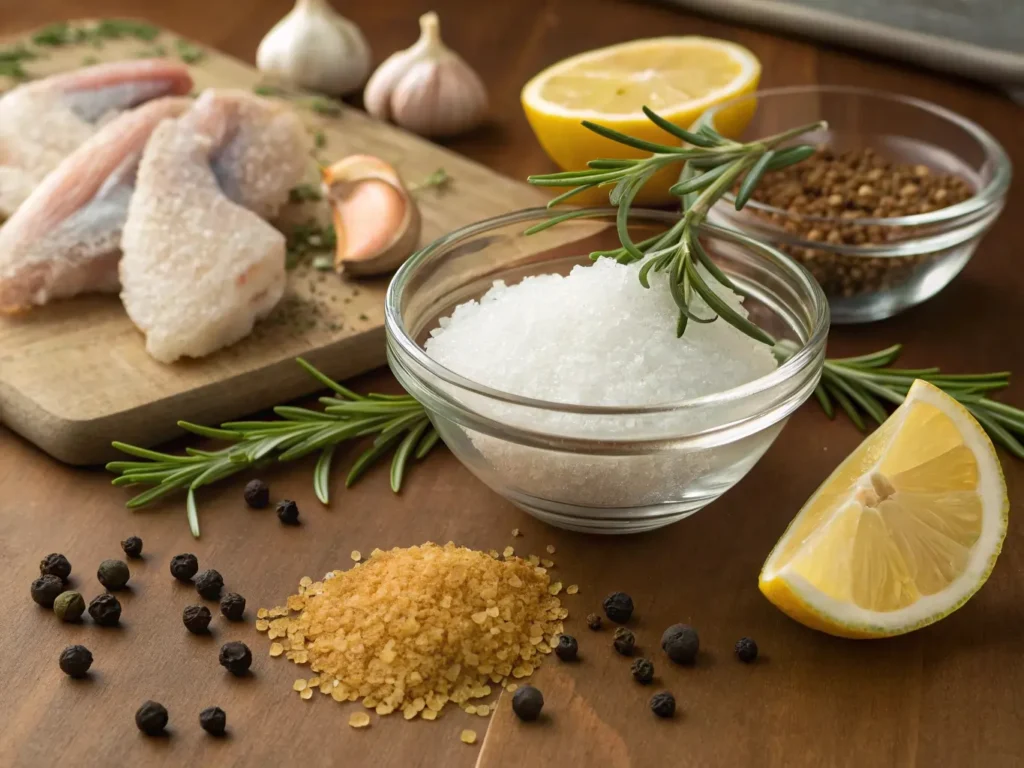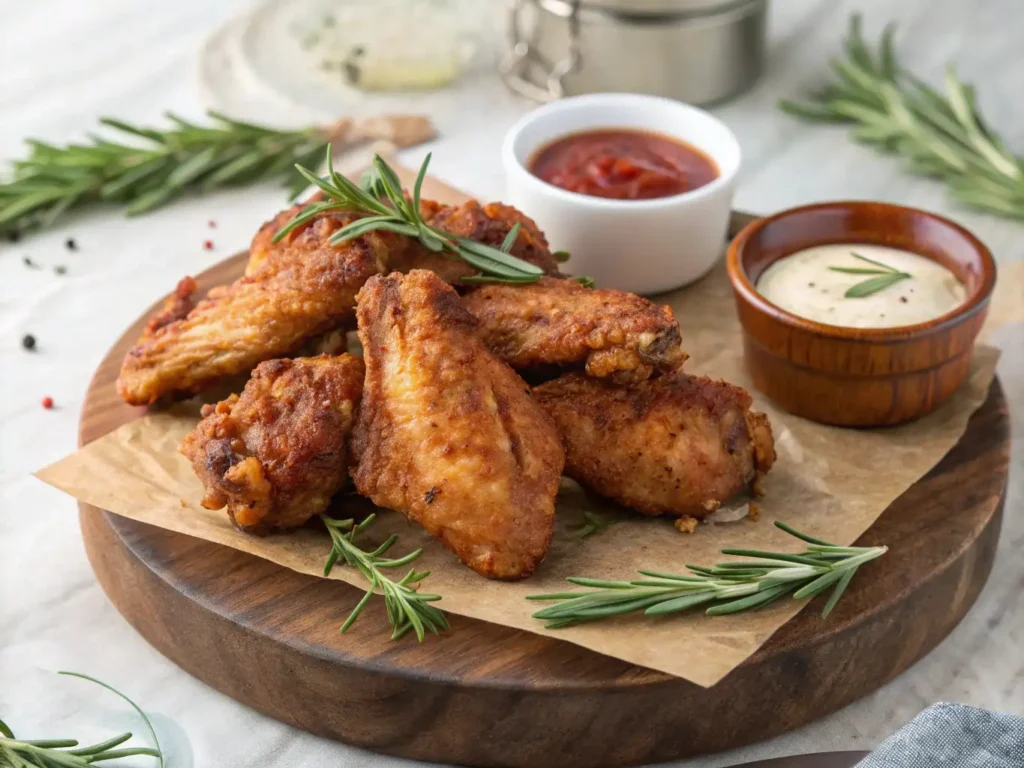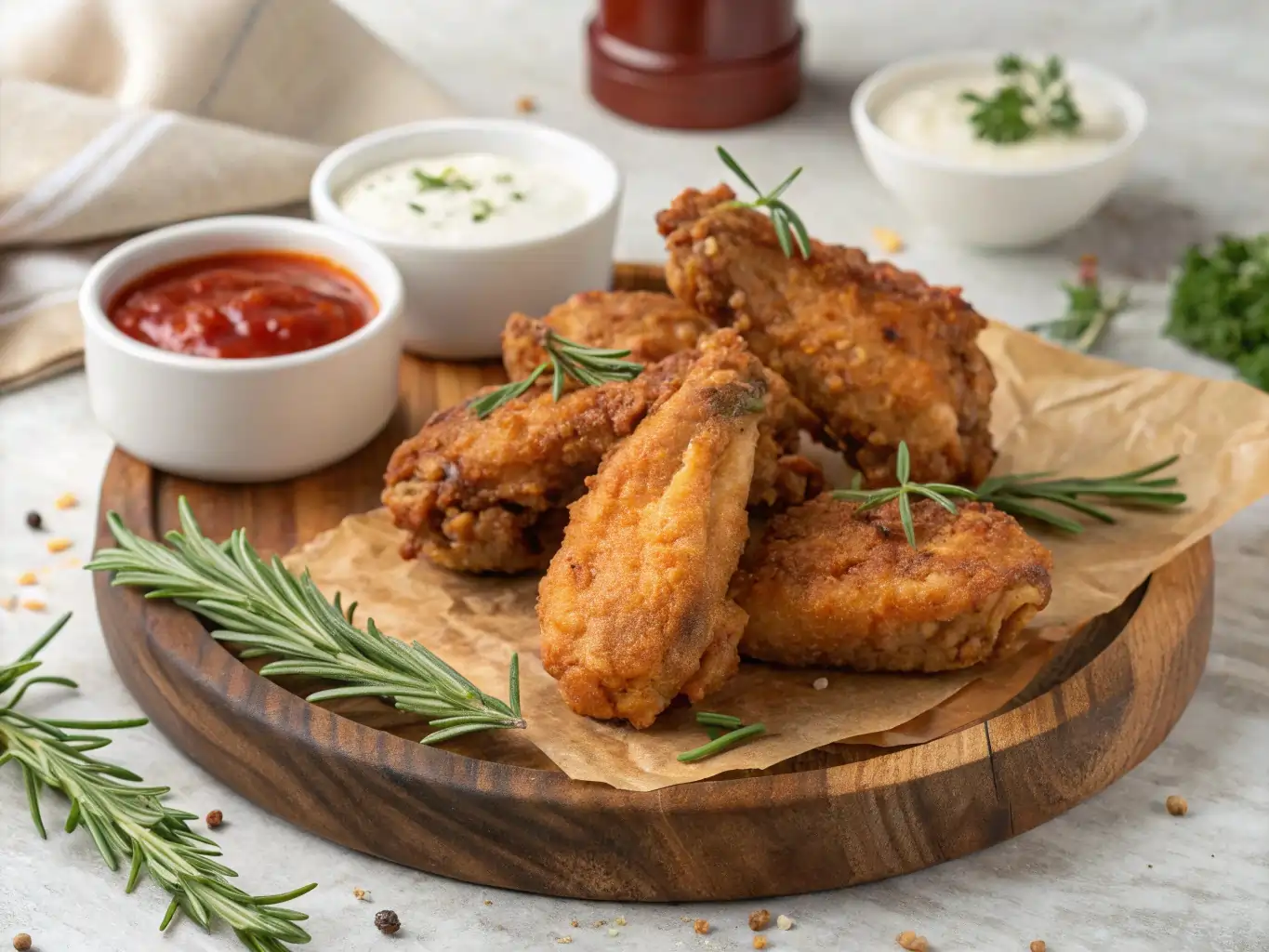Brine Chicken Wings is an age-old culinary technique that has stood the test of time, celebrated for its ability to transform simple cuts of meat into succulent, flavorful dishes. When it comes to chicken wings, brining is a game-changer. This method involves soaking the wings in a solution of salt, water, and other flavorful ingredients, allowing them to absorb moisture and seasonings that penetrate deep into the meat. The result? Wings that are not only juicy and tender but also bursting with flavor.
In this blog post, we will delve into the art and science of brining chicken wings to achieve maximum flavor. Whether you are preparing for a casual family dinner or a festive gathering, mastering the technique of brining can elevate your chicken wings from ordinary to extraordinary. We will guide you through the essentials of creating a perfect brine solution, share tips on enhancing flavors with herbs and spices, and explore various cooking techniques to ensure that your wings are cooked to perfection.
With the right approach and a little experimentation, you’ll find that brining is a simple yet powerful tool in your culinary arsenal. So, let’s dive into the world of brining and discover how to make your chicken wings the star of any meal.
Table of Contents
Understanding the Basics of Brining Chicken Wings:
Brining is a culinary technique that involves soaking meat in a solution of salt, water, and various flavor-enhancing ingredients. This process is particularly beneficial for chicken wings, which can sometimes become dry and lackluster if not cooked properly. By understanding the basics of brining, you can ensure your chicken wings are moist, tender, and bursting with flavor.

What is Brining?
Brining is more than just a simple soak; it’s a transformative process that alters the cellular structure of the meat. When chicken wings are submerged in a brine solution, osmosis occurs. The salt in the brine draws out some of the meat’s natural juices, which are then replaced with the flavorful liquid of the brine. This not only increases the moisture content of the wings but also allows the flavors to penetrate deeply into the meat.
Key Ingredients for a Basic Brine:
At its core, a brine solution consists of three primary ingredients: salt, sugar, and water. Salt is the crucial component, as it is responsible for the osmosis process and enhances the overall flavor. Sugar helps caramelize food during cooking and imparts a delicate sweetness. Water acts as the medium to dissolve these ingredients and distribute them evenly.
To elevate your brine, consider adding herbs and spices such as garlic, thyme, rosemary, or black pepper. These ingredients infuse the wings with additional layers of flavor, making each bite a sensory delight.
Importance of Correct Ratios:
The success of your brine largely depends on getting the ratios right. A general rule of thumb is to use about 1 cup of salt and 1/2 cup of sugar for every gallon of water. However, these proportions can be adjusted based on personal preference and the specific recipe you’re following.
It’s crucial to ensure that the salt and sugar are fully dissolved in the water before adding the chicken wings. This ensures even distribution and prevents any spots from becoming overly salty or sweet.
By mastering the basics of brining, you lay the foundation for creating chicken wings that are not only delicious but also consistently impressive. With these principles in mind, you’re ready to explore more advanced brining techniques and experiment with flavors to suit your palate.
Step-by-Step Guide to Brining Chicken Wings:
Brining chicken wings is a straightforward process that can significantly enhance their flavor and juiciness. By following this step-by-step guide, you’ll learn how to create the perfect brine solution and ensure your wings are deliciously tender and packed with flavor.

Preparing the Brine Solution:
- Gather Your Ingredients:
- Start by gathering your essential ingredients. You will need:
- 1 cup of salt (kosher or sea salt works best)
- ½ cup of sugar (brown or white)
- 1 gallon of water
- Optional: herbs and spices (such as garlic cloves, black peppercorns, bay leaves, or fresh herbs) to enhance flavor.
- Start by gathering your essential ingredients. You will need:
- Mix the Brine:
- In a large pot, combine the salt and sugar with about 2 cups of warm water. Keep stirring until every bit of the sugar and salt has fully dissolved.
The warm water helps dissolve these ingredients more effectively. - Once dissolved, add the remaining water to the mixture to cool it down to room temperature. It’s important that the brine is not hot when you add the chicken wings, as it could start to cook them.
- In a large pot, combine the salt and sugar with about 2 cups of warm water. Keep stirring until every bit of the sugar and salt has fully dissolved.
- Add Flavorings:
- If you want to infuse additional flavors into your wings, now is the time to add your chosen herbs and spices. For example, you might crush a few garlic cloves, add a handful of fresh thyme or rosemary, or toss in some black peppercorns. These ingredients will impart wonderful flavors to the wings as they brine.
Submerging the Chicken Wings:
- Prepare the Chicken Wings:
- Rinse the chicken wings under cold water to remove any residual blood or impurities. Pat them dry with paper towels to ensure they are not too slippery when handling.
- Brining Process:
- Place the chicken wings in a large, non-reactive container (such as a glass or stainless steel bowl, or a food-safe plastic bag). Pour the prepared brine over the wings, ensuring they are fully submerged. If necessary, you can weigh them down with a plate or a lid to keep them submerged.
- Refrigerate:
- Place the container in the refrigerator after covering it with a lid or plastic wrap. The ideal brining time for chicken wings is between 2 to 4 hours. For best results, avoid brining for more than 6 hours, as extended soaking can lead to overly salty wings.
Ideal Brining Time:
- Timing is Key:
- After the brining period, remove the wings from the brine solution. It’s essential to drain off the brine and pat the wings dry with paper towels. This step helps to remove excess moisture and ensures a crispy exterior when cooking.
- Rinse (Optional):
- Some cooks choose to give the wings a quick rinse under cold water after brining to remove any excess salt. This is optional and depends on your taste preference, but it can help balance the flavor if you are concerned about saltiness.
Enhancing Flavor with Additional Ingredients:
While the basic brine solution of salt, sugar, and water provides a solid foundation for juicy and flavorful chicken wings, adding extra ingredients can elevate the taste profile to new heights. These enhancements allow you to customize the flavor to suit your palate or the occasion. Here’s how you can enhance your brine with additional ingredients:

Herbs and Spices to Elevate Taste:
- Classic Herb Blends:
- Incorporate fresh or dried herbs such as rosemary, thyme, or sage into your brine. These aromatic ingredients infuse the chicken wings with subtle earthy and savory notes. For a Mediterranean twist, consider adding oregano and basil.
- Spice it Up:
- Adding spices like black peppercorns, crushed red pepper flakes, or paprika can introduce a hint of heat and complexity. For a smoky undertone, try incorporating smoked paprika or chipotle powder.
- Sweet and Savory Combinations:
- Balance flavors by combining sweet spices like cinnamon or allspice with savory ones. This can create a unique flavor profile that tantalizes the taste buds.
Experimenting with Liquid Additions:
- Acidic Ingredients:
- Incorporate acidic liquids such as apple cider vinegar, lemon juice, or even a splash of white wine into the brine. These components help tenderize the meat further and add a bright, tangy flavor that pairs well with the richness of chicken wings.
- Flavorful Broths or Juices:
- Replace some of the water in your brine with chicken broth, vegetable stock, or fruit juices like apple or orange juice. These liquids introduce additional layers of flavor that enhance the overall taste of the wings.
- Beer or Wine:
- For a unique twist, consider adding beer or wine to the brine. These alcoholic beverages can impart complex flavors and aromas, from the malty depth of a stout to the fruity notes of a white wine.
Incorporating Aromatics:
- Garlic and Onion:
- Crush a few cloves of garlic or add sliced onions to the brine for a savory depth. These aromatics release their flavors slowly, ensuring a well-rounded taste throughout the brining process.
- Citrus Zest:
- Add the zest of lemons, limes, or oranges to the brine for a burst of citrusy brightness. The oils in the zest contribute a fresh, vibrant flavor that complements the savory elements of the brine.
- Ginger and Other Roots:
- Introducing sliced fresh ginger or galangal can add a warm, spicy note to your brine. These roots provide an exotic twist that pairs well with both sweet and savory flavors.
Cooking Techniques for Perfectly Brined Chicken Wings:
Once you’ve brined your chicken wings to perfection, the next step is cooking them using the right techniques to achieve that ideal combination of crispy skin and juicy meat. Here are three popular cooking methods to prepare your brined chicken wings, each offering a unique flavor and texture.

Grilling Brined Wings:
- Preheat the Grill:
- Begin by preheating your grill to medium-high heat. This ensures that the wings cook evenly and develop a nice char on the outside.
- Prepare the Wings:
- Take the wings out of the brine and dry them thoroughly using paper towels. This process is key for attaining a crispy skin. If desired, toss the wings with a light coating of oil and your favorite seasoning blend for added flavor.
- Grill to Perfection:
- Place the wings on the grill, making sure to leave space between them for even cooking. Grill the wings for about 20-25 minutes, turning occasionally to ensure they cook evenly. The wings are done when they reach an internal temperature of 165°F (74°C) and have a beautifully charred exterior.
- Finishing Touches:
- For extra flavor, consider brushing the wings with your favorite barbecue sauce or glaze during the last few minutes of grilling. This caramelizes the sauce, creating a delicious sticky coating.
Baking Brined Wings:
- Preheat the Oven:
- Preheat your oven to 425°F (220°C). A high temperature will help the wings crisp up nicely.
- Prepare the Baking Sheet:
- Cover a baking sheet with aluminum foil for effortless cleaning, then set a wire rack on it. This facilitates proper air circulation around the wings, ensuring they cook evenly and become crispy.
- Arrange the Wings:
- Place the brined and dried wings in a single layer on the wire rack. This setup helps the fat render out and allows the skin to become crispy.
- Bake for Crispiness:
- Roast the wings for 40–45 minutes, turning them over halfway through the cooking time. Keep an eye on them toward the end to ensure they don’t overcook. When they are golden brown and crispy, they are ready to be enjoyed.
- Optional Broiling:
- For an extra crispy finish, you can broil the wings for 2-3 minutes at the end of the baking process. Simply keep an eye on them to avoid burning.
Frying Brined Wings:
- Heat the Oil:
- In a deep fryer or sturdy, heavy-bottomed pot, warm the oil until it reaches 350°F (175°C). Ensure you have enough oil to fully submerge the wings for even cooking.
- Prepare the Wings:
- Remove the wings from the brine and pat them dry thoroughly. This step helps to avoid oil splatter during frying. You can also lightly coat the wings in a seasoned flour mixture for a crispy outer layer.
- Fry in Batches:
- Carefully add the wings to the hot oil, frying them in batches to avoid overcrowding the pan. Fry for about 8-10 minutes or until they are golden brown and have reached an internal temperature of 165°F (74°C).
- Drain and Season:
- Using a slotted spoon or tongs, lift the wings out of the oil and set them on a plate lined with paper towels to drain off any extra oil. While they are still hot, toss the wings in your favorite sauce or seasoning for added flavor.
Troubleshooting Common Brining Issues:
Brining is a relatively simple yet highly effective technique for enhancing the flavor and juiciness of chicken wings. However, like any cooking method, it can come with its own set of challenges. Understanding how to troubleshoot common brining issues can ensure that your wings turn out perfectly every time.

Avoiding Over-Brining:
- Signs of Over-Brining:
- Over-brining can lead to overly salty wings or a mushy texture, as the meat absorbs too much liquid. This often occurs when the wings are left in the brine solution for too long.
- Solutions:
- To avoid over-brining, adhere to recommended brining times—typically between 2 to 4 hours for chicken wings. If you suspect that you’ve over-brined, try rinsing the wings under cold water to remove excess salt. Pat them dry thoroughly before cooking.
- Prevention:
- Set a timer or reminder to ensure you don’t forget about the wings in the brine. If you’re experimenting with a new brine recipe, start with a shorter brining time and adjust based on the results.
Adjusting Flavors:
- Balancing Saltiness:
- If the brine is too salty, you can dilute it by adding more water and rebalancing the salt and sugar according to the new volume. Always taste the brine before adding the wings to ensure it’s not overly salty.
- Enhancing or Reducing Sweetness:
- If the brine is too sweet, reduce the amount of sugar in subsequent batches. Conversely, if you desire a sweeter profile, gradually increase the sugar content, ensuring it doesn’t overpower the savory elements.
- Flavor Adjustments:
- If the flavor profile isn’t to your liking, experiment with different herbs, spices, and liquids. Keep track of adjustments to refine the brine recipe to your preference.
Storage and Safety Tips:
- Food Safety:
- Always brine chicken wings in the refrigerator to prevent bacterial growth. Never leave the brining wings at room temperature, as this can lead to foodborne illnesses.
- Container Choice:
- Use non-reactive containers, such as glass, stainless steel, or food-safe plastic, to avoid any unwanted chemical reactions that can affect flavor. Ensure the container is large enough for the wings to be fully submerged.
- Proper Disposal:
- Once you’ve finished brining, discard the brine solution. It is not safe to reuse, as it contains raw chicken juices which can harbor bacteria.
FAQ
How to brine chicken wings?
- To brine chicken wings, mix a solution of water, salt, and sugar, along with any desired herbs and spices. Submerge the wings in the brine solution, ensuring they are fully covered, and refrigerate for the recommended time.
How long to brine chicken wings?
- Chicken wings should be brined for 2 to 4 hours. Avoid brining for longer than 6 hours to prevent them from becoming overly salty or mushy.
Should you brine chicken wings?
- Yes, brining chicken wings enhances their flavor and tenderness by allowing them to absorb moisture and seasonings, resulting in juicier and more flavorful wings.
Should I brine chicken wings?
- If you want to elevate the flavor and juiciness of your chicken wings, brining is highly recommended. It’s particularly beneficial for achieving tender meat and a deliciously seasoned exterior.
How do you brine chicken wings?
- To brine chicken wings, dissolve salt and sugar in water to create a brine solution, optionally adding herbs and spices for flavor. Submerge the wings in the solution for 2 to 4 hours in the refrigerator, then rinse and cook as desired.
Conclusion
Brining chicken wings is a transformative technique that elevates this popular dish to new heights of flavor and juiciness. By soaking the wings in a carefully crafted brine, you infuse them with moisture and seasoning that ensures each bite is succulent and satisfying. Throughout this post, we’ve explored the essentials of creating a perfect brine solution, from understanding the fundamental ingredients to experimenting with additional flavors that suit your palate.
Whether you prefer the smoky char of grilled wings, the crispy texture achieved through baking, or the indulgent crunch of frying, brining sets the stage for culinary success. We’ve discussed various cooking techniques that complement brined wings, allowing you to choose the method that best fits your taste and occasion.
Moreover, addressing common brining issues ensures that you’re equipped to troubleshoot any challenges, ensuring consistently delicious results. With practical solutions and tips, you can confidently refine your brining process and avoid pitfalls like over-brining or imbalanced flavors.
As you embark on your culinary journey with brined chicken wings, we encourage you to experiment with different herbs, spices, and flavor combinations. The versatility of brining offers endless possibilities, allowing you to tailor each batch to your liking, whether for a casual family dinner or an impressive gathering with friends.
Ultimately, mastering the art of brining is about enhancing the natural flavors of chicken wings and bringing joy to those who partake in your creations. We hope this guide has provided you with the knowledge and inspiration to make your chicken wings the star of any meal. Happy cooking!

